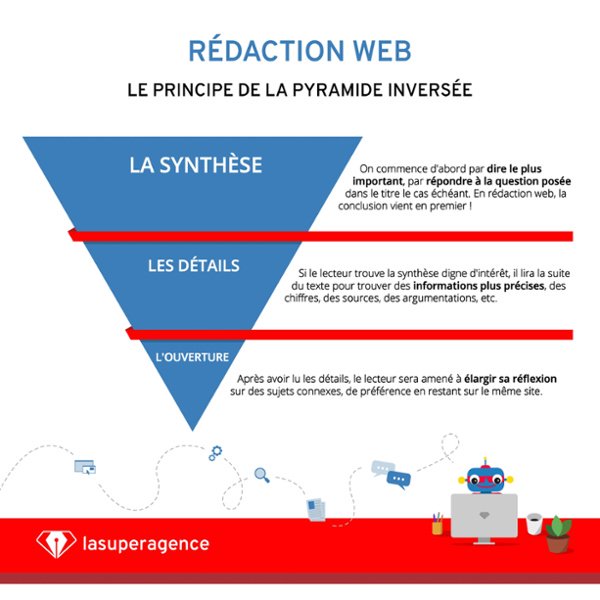You've probably already read or heard that it's very useful to launch your blog to get the word out about your business.
In fact, a corporate blog allows you to increase the visibility of your brand, it also allows you to establish a direct link with your visitors. It is an essential tool of Content Marketing.
But who says blogging necessarily says "writing articles regularly" - and that may chill some!
To help you get started, nothing beats a few tips. That's why the Super Agency describes the 7 key steps that will allow you to produce the best blog posts possible...and with a smile!"
1 - Plan your topics
It's likely that you'll want to start writing an article without further ado after reading this.
But of what do you speak ?
On average, a good blog post is going to take you at least a good two hours.
You read that correctly: between the moment you type your first letter on your keyboard and the moment you click on " publish ", there will be a considerable time . < >
No doubt that, as an entrepreneur, you don't have two hours of your time to waste. Might as well make the most of them, right?
To do this, take a moment to think about a plan. This step may seem unnecessary, but in reality, it will save you a lot of time for the rest.
The topic

Understanding your target will save you valuable time.
First, choose a topic that interests both your Buyer Persona... and yourself !
Having previously worked on your Buyer Persona, you surely know the topics that will catch their attention.
But also remember to choose a theme that you also have an interest in. Otherwise, your lack of enthusiasm may show in your style and you may quickly bore your readers.
To do this, schedule a little brainstorming with the other people who work on the blog - if there are any - and list all the possible topics that may be of interest to your Buyer Persona.
If you're lacking inspiration, you should know that Hubspot provides a pretty effective blog topic generator you can find more here and here.
Then rate your own interest in each topic from 1 to 5. By keeping only the topics that score above 4, you will then have a list of blog posts that you can address in the coming weeks or months.
What about the other topics that you are less enthusiastic about ? They will serve as the basis for F FAQs type articles:" The 10 questions you have about ... ".
Rather than devote an entire article to them, you will address these topics with a single paragraph.
If you come across a news topic that immediately grabs your attention, it will probably also be a good idea to address it on the fly.
The Structure

A good blog post is one that is read in its entirety
A good blog post doesn't just happen. You have to think about it before you write it and know its path in advance.
This step will surely remind you of the painful hours of the famous " essays" in college, but it is nonetheless essential.
For the overall structure of your paper, keep in mind the principle of the inverted pyramid:

The inverted pyramid? A reflex to adopt to improve the performance of your blog
It is also appropriate to make a detailed plan. To write this article, I thus began by writing this :
Introduction
Part 1 : Planning
List topics in advance that interest the writer and the reader
Part 2 : The research
Show that a lot of information must be sought
Part 3 : The writing
Give tips on how to write your articles well
Part 4 : Choosing images
Giving tips for choosing what to illustrate your article
Part 5 : Correction
Provide techniques to correct major editing errors
Part 6 : Optimization
Indicate how to optimize an article for SEO, social media, etc.
Conclusion.
The purpose of this outline is to show the different sections so as not to forget anything.
2 - Do some research
Reliable and relevant sources to meet your readers' need for information
It would be wrong to assume that you know everything about a subject because it is your job. It is better to be honest (with yourself to begin with) and accept that you will have to undertake research on the subject you are dealing with.
This work takes time and some common sense. Wikipedia, for example, is a fairly reliable source of information most of the time but certainly not infallible.
So the best thing to do is to copy the information you are copying with one, or even several, reputable sources such as official or government sites.
You are not being asked to demonstrate unstoppable journalistic rigor but only to be pretty sure of what you are saying.
If you are quoting a famous person, make sure they actually said that phrase.
3 - Choose your titles well

Source: Flickr @PhilippaWillitts
Everyone has an opinion about titles. Some think they should be written in a very descriptive way to guide the reader as in a textbook, others on the contrary lean towards choosing more abstract, titles, as in some news articles (e.g. " A very singular vision... " or " The carp and the rabbit... ").
Unless you are a well-recognized figure in your field, we still recommend sticking to descriptive titles.
Also, choosing titles can be done in two other ways.
Either you determine them in advance and they will be the structure of your article, or you write your paragraphs and choose a title that fits well with the idea of the text. No one approach is better than the other.
In some cases, one will work better than the other according to your readers.
A common technique is to ask a question.
This can be very effective in capturing your reader's interest. However, be careful not to overuse it as the effect produced fades rather quickly.
If you're wondering about the impact of your headlines (outside of H1) on your SEO, know that it is very relative.
The search engine algorithm hasn't been fooled by keyword-filled titles for a long time. It's what's underneath that counts !
4 - Work on your writing

Source: Flickr @CristianAllendes
We're getting to the heart of the matter !
To write a coherent article, it is highly recommended to write it in one sitting.
This keeps the mind focused on the subject and minimizes the risk of major oversights.
If for practical reasons you cannot write in one piece, still try to complete an entire subpart each writing session.
There really isn't a trick or " hack " that applies for this work in general. Writing is a skill that develops with practice, like piano or dance.
The only way to progress is to spend a lot of time on a keyboard so that at some point, the text comes out naturally, expressing your ideas in the most fluent way possible.
Avoid as much as possible figures of speech and convoluted formulas.
You are not running a literary blog, the important thing is to be understood, not admired for your style.
5 - Choose your images appropriately

There are types of images to avoid for your blog
Writing for the web is a special exercise, very different from writing for a print medium.
On a digital medium, people are often in a hurry, and are going to be very influenced by visual stimuli.
If you use only text, even with nice formatting, it's a safe bet that users will quickly look elsewhere.
Hence the crucial importance of images to keep their attention.
Keep in mind 3 main principles:
Images serve to make reading more comfortable : they are there to " break " the text and make it less arduous to read.
Images are used to support your proposal : a well-chosen image can be very helpful in getting your reader to go your way.
Images are used to simplify complex subjects : everyone knows Confucius' maxim " A picture is worth a thousand words ".
Don't hesitate to use infographics if you need to advance a lot of figures.
6 - Correct yourself
This step is much harder than it sounds. It's not just about correcting typos and grammatical errors, but more importantly ensuring maximum readability of your text.
This may mean deleting an entire paragraph if you feel it goes too far off topic.
A sacrifice that is sometimes hard but essential to the overall coherence of the article.
You will therefore need to spot repetitions, of words of course but also of ideas. To do this, you can ask a colleague to proofread for you or reread your text out loud.
This last technique may sound strange, but you'll realize that many mistakes come out clearly when you say them.
A common mistake is to add subordinate clauses to the string. Whenever your sentences sound too long to the ear, don't hesitate to cut them.
7 - Optimize

Source: Flickr @SarahTarno
In order for it to be read by internet users, your text must be optimized for search engines. Here is a list of the main actions to take on a blog post to increase your chances of appearing in good position.
Never copy text : Google favors originality and quality of content and judges copying very negatively. To ensure good SEO, get inspired by others, but without copying them !
Use keywords : your text will need to have a number of word sequences that can match what your buyer persona would type. This will mean changing a few passages in your original text. So these insertions will need to appear as naturally as possible.
Describe your images : search engines cannot " see " your images. So you will have to fill in the "alt" tag allowing them to index them.
Add links : links are the foundation of SEO. Link your post with other posts on your blog but also with other blogs.
Respond to comments : content produced in comments is indexed. By replying to your readers, you will help update the content which will beneficially affect your SEO.
Add sharing buttons : with these buttons, your readers will be able to share your article with their friends. Caught in this dynamic, it will be spotted by Google, which will make it move up in the search results.
You're up!
Now you are better equipped to start writing your first articles. As you can see, there is nothing magical about this job.
With a little method and a lot of persistence, you'll quickly see your articles being read by your customers.
Do you have something to add to this article? Leave a comment to let us know or simply tell us what you think of this article.












